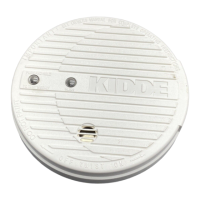• Practice a fire drill at least every six months, including fire drills at
night. Ensure that small children hear the alarm and wake when
it sounds. They must wake up in order to execute the escape
plan. Practice allows all occupants to test your plan before an
emergency. You may not be able to reach your children. It is
important they know what to do.
• Install and maintain fire extinguishers on every level of the home
and in the kitchen, basement and garage. Know how to use a
fire extinguisher prior to an emergency.
• Current studies have shown smoke alarms may not awaken all
sleeping individuals, and that it is the responsibility of individuals
in the household that are capable of assisting others to provide
assistance to those who may not be awakened by the alarm
sound, or to those who may be incapable of safely evacuating
the area unassisted.
WHAT TO DO WHEN THE ALARM SOUNDS
• Alert small children i n the home.
•
L
eave immediately by your escape plan. Every second counts, so
don’t waste time getting dressed or picking up valuables.
• In leaving, don’t open any i nside door without first feeling its sur-
face. If hot, or if you see smoke seeping through cracks, don’t
open that door! Instead, use your alternate exit. If the inside of
the door is cool, place your shoulder against it, open it slightly
and be ready to slam it shut if heat and smoke rush i n.
•
S
tay close to the floor if the air is smoky. Breathe shallowly through
a cloth, wet if possible.
• Once outside, go to your selected meeting place and make sure
everyone is there.
• Cal l the fire department from your neighbor’s home - not from
yours!
• Don’t return to your home until the fire officials say that it is all
right to do so.
There are situations where a smoke al arm may not be effective to
protect against fire as stated in the NFPA
S
tandard 72. For instance:
a
)
smoking in bed
b
)
leaving children home al one
c
)
cleaning with flammable liquids, such as gasoline
9. NRC INFORMATION
Ionization type smoke alarms use a very small amount of a
radioactive element in the sensing chamber to enable detection of
visible and invis ible combustion products. The radioactive element
is safely contained in the chamber and requires no adjustments or
maintenance. This smoke alarm meets or exceeds all government
standards. It is manufactured and distributed under license from
the U.
S
. Nuclear
R
egulatory Commission.
10. NFPA REQUIRED PROTECTION
The National Fire Protection Association’s
S
tandard 72 provides the
following information:
S
moke Detection - Where required by applicable laws, codes, or
standards for the specified occupancy, approved single- and multi-
ple-station smoke alarms shall be installed as follows:
(
1
)
In all
sleeping rooms Exception:
S
moke alarms shall not be required in
sleeping rooms in existing one- and two-family dwelling units.
(
2
)
Outside of each separate sleeping area, in immediate vicinity of
the sleeping rooms.
(
3
)
On each level of the dwelling unit, includ-
ing basements Exception: In existing one- and two-family dwelling
units, approved smoke alarms powered by batteries are permitted.
S
moke Detection - Are More
S
moke Alarms Desirable? The
required number of s moke alarms might not provi de reliable early
warning protection for those areas separated by a door from the
areas protected by the required smoke alarms. For this reason, it is
recommended that the householder consider the use of additional
smoke alarms for those areas for increased protection. The addi-
tional areas include the basement, bedrooms, dining room, fur-
nace room, utility room, and hallways not protected by the
required smoke alarms. The instal lation of the smoke alarms in
the kitchen, attic
(
finished or unfinished
)
, or garage is normally not
recommended, as thes e locations occasionally experience condi-
tions that can result in improper operation.
This equipment should be installed in accordance with the
National Fire Protection Association’s
S
tandard 72
(
NFPA,
Batterymarch Park, Quincy, MA 02269
)
.
NOTIFY YOU
R
L
OCA
L
FI
R
E DEPA
R
TMENT AND IN
S
U
R
ANCE COM-
PANY OF YOU
R
S
MOKE A
L
A
R
M IN
S
TA
LL
ATION.

